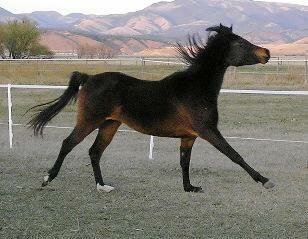| Cerebellar Abiotrophy in Arabian Horses - viewed 602419 times |  |
 |
|
A.F. Vesjnica; CA Affected filly. Click HERE to read her story
Welcome ! We are here to inform you about Cerebellar Abiotrophy (CA) in Arabian Horses... If you want to stay informed about the latest developments about CA, please register yourself and we will mail the latest news ! The information on this site is all from publicly available information. Where private sources are included, permission is noted. Our goal is to collect information on Cerebellar Abiotrophy on a One-Stop site from which all can learn. Cerebellar Abiotrophy (CA) also referred to as Cerebellar Cortical Abiotrophy (CCA), is a neurological condition affecting the neurons known as Purkinje cells in the cerebellum of the brain, causing them to die off. With CA, the Purkinje cells do not regenerate and once atrophied, their useful life is lost permanently. These cells affect balance and coordination. Put simply, without Purkinje cells, an animal loses its sense of space and distance, making balance and coordination difficult. In most cases, the neurons begin to die off shortly after the animal is born and the condition is noticeable when the animal is less than six months old, though sometimes the onset of symptoms is gradual and the animal is much older before the owner or caretaker notices a problem. Cerebellar Abiotrophy is different from Cerebellar Hyperplasia. Research since 1967 indicates that CA is thought to be an autosomal recessive mode of inheritance.
An affected foal is usually born without any clinical signs (symptoms), but after 6 weeks and even as late as 18 months the following notable clinical signs may be observed: A palsy-like head shaking called ‘intention tremors’ affecting only the head and not the neck or body, particularly noticeable when the foal is trying to focus on something; the lack of a normal blink response although vision is correct; and an awkward exaggerated form of action with the forelimbs called ‘hyper-metric action’ similar to a military goose-step or high elevation used to cross over a very low object. Sometimes in a badly affected individual it appears that the hind legs are also affected, but not usually. This hyper-metric action involves a shooting out and up of the foreleg directly from the elbow at both the walk and the trot. The hoof is brought down to the ground with a thump, often heel first. When cantering on level ground the horse looks as if it is cantering uphill, like a butterfly stroke in swimming. It is a highly exaggerated gait. The more stressed the horse, the more exaggerated the gait. Their spinal column is not involved; they do not lose weight; they are not in pain; they are neither lethargic nor show signs of increasing weakness, or loss of muscle tone.
Although the clinical signs are distinctive, the only definitive confirmation for a diagnosis of CA is to examine the brain after euthanasia. The two parents of an affected horse will be CA Carriers. Extensive research to identify the defective gene and create a DNA based test is under way at UC Davis Veterinary Genetics Laboratory (VGL) in the USA. Continuing the research started in 1985 by the late Dr. Ann T Bowling, well-known author and geneticist, Dr. Cecilia Penedo and her assistant Leah Brault has identified a mutation that is associated with CA. This mutation is now part of the CA test being offered by the UC Davis VGL and other laboratories. This is an important advancement, as it moves the initially developed CA test from a marker based screening test to a more fully developed DNA test. More information: http://www.vgl.ucdavis.edu/genomic/cerebellar/ To order tests from variuos genetic test labs around the world, click HERE Dr. Maria Cecilia Torres Penedo Cecilia Penedo supervises the camelid and cattle blood and DNA typing unit of the Veterinary Genetics Laboratory, School of Veterinary Medicine, University of California, Davis. Dr. Penedo received her PhD in Genetics from UC Davis in 1999. Dr. Penedo’s main research experience and expertise are in the study of genetic markers in several major species of domestic animals. She is a recognized leading researcher in the molecular genetic studies of the South American camelids. Most recently she has focused on the study of genetic diversity of rhesus macaques. Dr. Penedo has also assumed the research projects in horse genomics that had been initiated by the late Dr. Ann Bowling. These projects pertain to the development of a genome-scan microsatellite panel for linkage analysis and chromosomal location of traits of interest. As of 2002, with her assistant Leah Brault, she has been researching the location and identity of the mutant allele associated with cerebellar cortical abiotrophy in arabian horses and their derivatives. As of 2007, the locus has been established and the marker cluster associated with the defective allele. © EG-C, 02-IV-09 Latest Posts:
|

 A two-year-old Arabian horse with cerebellar abiotrophy, showing stiff awkward gait, and upper range of unnatural head bob. Though this horse has a relatively mild case, it cannot ever be ridden.
A two-year-old Arabian horse with cerebellar abiotrophy, showing stiff awkward gait, and upper range of unnatural head bob. Though this horse has a relatively mild case, it cannot ever be ridden.